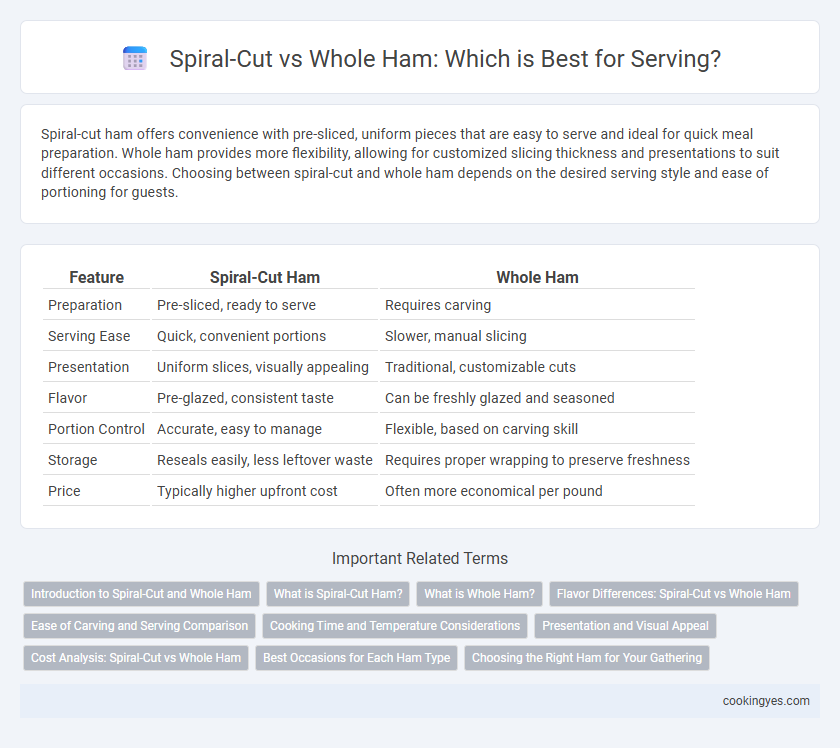Spiral-cut ham offers convenience with pre-sliced, uniform pieces that are easy to serve and ideal for quick meal preparation. Whole ham provides more flexibility, allowing for customized slicing thickness and presentations to suit different occasions. Choosing between spiral-cut and whole ham depends on the desired serving style and ease of portioning for guests.
Table of Comparison
| Feature | Spiral-Cut Ham | Whole Ham |
|---|---|---|
| Preparation | Pre-sliced, ready to serve | Requires carving |
| Serving Ease | Quick, convenient portions | Slower, manual slicing |
| Presentation | Uniform slices, visually appealing | Traditional, customizable cuts |
| Flavor | Pre-glazed, consistent taste | Can be freshly glazed and seasoned |
| Portion Control | Accurate, easy to manage | Flexible, based on carving skill |
| Storage | Reseals easily, less leftover waste | Requires proper wrapping to preserve freshness |
| Price | Typically higher upfront cost | Often more economical per pound |
Introduction to Spiral-Cut and Whole Ham
Spiral-cut ham is pre-sliced in a continuous spiral, allowing for easy serving and consistent portion sizes, making it ideal for large gatherings or buffet-style meals. Whole ham remains intact, offering versatility for carving thick or thin slices and providing a traditional presentation suited for formal dinners. Both options come from the same cured pork leg but differ in preparation and serving style, affecting texture and convenience.
What is Spiral-Cut Ham?
Spiral-cut ham is pre-sliced in a continuous, thin spiral around the bone, making it easy to serve and ensuring even portions. This method enhances flavor absorption from glazes and marinades due to increased surface area. Compared to whole ham, spiral-cut ham offers convenience and consistent slices, ideal for large gatherings or quick meals.
What is Whole Ham?
Whole ham refers to an uncut, bone-in or boneless ham that is sold in its entirety, typically weighing between 8 to 20 pounds. This form allows for customization in slicing thickness and serving portions, making it versatile for various recipes and occasions. Whole ham retains more moisture and flavor compared to pre-sliced options, providing a juicy and tender eating experience when properly cooked.
Flavor Differences: Spiral-Cut vs Whole Ham
Spiral-cut ham offers enhanced flavor absorption as its thin, pre-sliced layers allow glazes and seasonings to penetrate deeply, resulting in a sweeter and more evenly seasoned taste. Whole ham retains more natural juiciness and a richer, traditional ham flavor due to minimal surface exposure during cooking, preserving its dense, meaty texture. Choosing between spiral-cut and whole ham affects flavor intensity and moisture retention, with spiral-cut favoring convenience and glaze infusion, while whole ham emphasizes classic taste and succulence.
Ease of Carving and Serving Comparison
Spiral-cut ham offers effortless slicing with pre-cut, uniform spirals that simplify serving and portion control. Whole ham requires more skill and time to carve, often resulting in uneven slices and potential waste. For gatherings, spiral-cut ham enhances convenience and presentation, while whole ham allows for custom slice thickness but demands more effort.
Cooking Time and Temperature Considerations
Spiral-cut ham requires careful heating at approximately 275degF to ensure even warming without drying, typically taking about 10-12 minutes per pound. Whole hams demand longer cooking times, around 18-20 minutes per pound, at temperatures ranging from 325degF to 350degF to penetrate the dense meat fully. Monitoring internal temperature to reach 140degF for pre-cooked hams or 160degF for fresh hams is crucial for safe and flavorful serving.
Presentation and Visual Appeal
Spiral-cut ham offers an attractive presentation with uniform, pre-sliced layers that highlight its juicy texture and make serving effortless at gatherings. Whole ham presents a rustic and traditional visual appeal, allowing guests to carve slices to their preferred thickness, enhancing the dining experience with fresh-cut portions. Choosing between spiral-cut and whole ham depends on the desired combination of convenience and an elegant, customizable display.
Cost Analysis: Spiral-Cut vs Whole Ham
Spiral-cut hams typically cost more per pound than whole hams due to the additional labor and processing required for pre-slicing, which enhances convenience at serving. Whole hams often provide better value, allowing consumers to slice portions as needed and reduce waste, maximizing cost efficiency. Price comparisons should also consider potential savings from leftovers, as whole hams tend to preserve freshness longer when properly stored.
Best Occasions for Each Ham Type
Spiral-cut ham is ideal for large gatherings and holiday meals due to its even slices that facilitate easy serving and consistent flavor distribution. Whole ham suits intimate dinners or special occasions where carving customization and presentation are prioritized. Selecting between spiral-cut and whole ham depends on the event size, serving style, and desired ease of preparation.
Choosing the Right Ham for Your Gathering
Choosing the right ham for your gathering depends on serving convenience and flavor preferences. Spiral-cut hams offer pre-sliced, easy-to-serve portions ideal for large groups, while whole hams provide customization in carving thickness and presentation. Consider the size of your event and ease of preparation to select the perfect ham that enhances your menu and satisfies your guests.
Spiral-Cut vs Whole Ham for Serving Infographic

 cookingyes.com
cookingyes.com